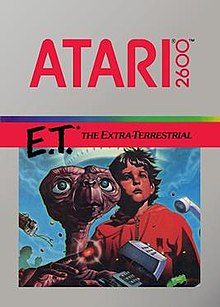| E.T. the Extra-Terrestrial | |
|---|---|
 Atari's silver label box art | |
| Developer(s) | Atari, Inc. |
| Publisher(s) | Atari, Inc. |
| Designer(s) | Howard Scott Warshaw |
| Platform(s) | Atari 2600 |
| Release | |
| Genre(s) | Adventure |
| Mode(s) | Single-player |
E.T. the Extra-Terrestrial is a 1982 adventure video game developed and published by Atari, Inc. for the Atari 2600 and based on the film of the same name. The game's objective is to guide the eponymous character through various screens to collect three pieces of an interplanetary telephone that will allow him to contact his home planet.
The game was designed by Howard Scott Warshaw, who intended it to be an innovative adaptation, but Atari held unrealistic expectations for sales based on the international box-office success of the film. Negotiations for the game rights ended in late July 1982, giving Warshaw just over five weeks to develop the game in time to meet the production schedule for the 1982 Christmas season.[2] The final release received negative reviews. The game is often cited as one of the worst of all time and one of the biggest commercial failures in video game history. It is cited as a major contributing factor to the video game crash of 1983, and has been frequently referenced and mocked in popular culture as a cautionary tale about the dangers of rushed game development and studio interference.
In what was once deemed only an urban legend, reports from 1983 stated that as a result of overproduction and returns, unsold cartridges were secretly buried in a landfill in Alamogordo, New Mexico, and covered with a layer of concrete. In April 2014, diggers hired to investigate the claim confirmed that the landfill contained several E.T. cartridges, among other games.[3][4][5] James Heller, the former Atari manager who was in charge of the burial, was at the excavation, and admitted to the Associated Press that 728,000 cartridges of various games (not just E.T.) were buried.[6] Marty Goldberg, co-author of the book Atari Inc.: Business Is Fun, added that the dump was in fact a clearing out of the Texas Atari manufacturing plant's unused cartridge stock of a number of titles, as well as console and computer parts.[7] According to the 2014 documentary Atari: Game Over, only 10% of the approximately 1,300 recovered were E.T. cartridges.
- ^ "E.T. Needs Your Help! (advertisement)". Atari Age. Vol. 1, no. 4. The Atari Club Inc. November–December 1982. p. 3. Archived from the original on May 14, 2020. Retrieved May 14, 2020.
- ^ Scott, Stilphen. "DP Interviews". Digitpress.com. Archived from the original on August 31, 2014. Retrieved March 6, 2014.
- ^ Goldsmith, Alex (May 30, 2013). "Alamogordo approves Atari excavation". ALAMOGORDO, N.M.: KRQE. Archived from the original on July 19, 2013. Retrieved May 31, 2013.
- ^ Schreier, Jason (April 26, 2014). "E.T. Found In New Mexico Landfill". Kotaku. Archived from the original on February 11, 2015. Retrieved February 4, 2015.
- ^ Llorca, Juan Carlos (September 28, 1983). "Diggers Find Atari's E.T. Games in Landfill". ABC News. Archived from the original on April 26, 2014. Retrieved April 26, 2014.
- ^ "Diggers find Atari's E.T. games in landfill". USA Today. April 26, 2014. Archived from the original on April 27, 2014. Retrieved April 26, 2014.
- ^ Poeter, Damon (June 5, 2013). "Debunking the Myth of the Buried Atari E.T. Cartridges". PCMag UK. Archived from the original on September 6, 2018. Retrieved September 6, 2018.